Effect of Indoor Environment on Occupant Air Comfort and Productivity in Office Buildings: A Response Surface Analysis Approach
Abstract
1. Introduction
2. Indoor Air Comfort
3. Research Design
3.1. Survey Design
3.2. Physical Parameters Measurement
3.3. Data Analysis: Response Surface Methodology
4. Results
4.1. Analysis of Variance
4.2. Regression Analysis
−0.370 Temperature + 0.1035 Outside Temperature
+0.0353 Outside Relative Humidity + 0.1930 Sound +
−0.863 Kind of Workspace_1 − 0.306 Kind of Workspace_2
+1.322 Kind of Workspace_3 + 0.47 Kind of Workspace_4
−0.621 Kind of Workspace_5 + 1.658 Do you sit near (wall type):_1
+0.241 Do you sit near (wall type):_2
−0.448 Do you sit near (wall type):_3
−1.451 Do you sit near (wall type):_4
4.3. Response Surface Analysis
4.3.1. Relationship between Outside Temperature, Illumination and Indoor Air Comfort and Productivity
4.3.2. Relationship between Outside Temperature, Sound and Indoor Air Comfort and Productivity
4.3.3. Relationship between Outside Temperature, Outside Relative Humidity and Indoor Air Comfort and Productivity
4.3.4. Relationship between VOC, Temperature and Indoor Air Comfort and Productivity
4.3.5. Relationship between VOC, Relative Humidity and Indoor Air Comfort and Productivity
4.3.6. Relationship between Cardon Dioxide, Illumination and Indoor Air Comfort and Productivity
4.3.7. Relationship between Sound, Carbon Dioxide and Indoor Air Comfort and Productivity
4.3.8. Relationship between Outside Relative Humidity, Carbon Dioxide and Indoor Air Comfort and Productivity
4.3.9. Relationship between Outside Temperature, Carbon Dioxide and Indoor Air Comfort and Productivity
4.3.10. Relationship between Temperature, Carbon Dioxide on Indoor Air Comfort and Productivity
4.3.11. Relationship between Relative Humidity, Carbon Dioxide and Indoor Air Comfort and Productivity
4.3.12. Effect of VOC and Carbon Dioxide on Indoor Air Comfort and Productivity
5. Discussion
5.1. Carbon Dioxide
5.2. Relative Humidity
5.3. Volatile Organic Compound
5.4. Outside Relative Humidity & Outside Temperature
5.5. Temperature
5.6. Illumination
6. Conclusions
Supplementary Materials
Author Contributions
Funding
Institutional Review Board Statement
Informed Consent Statement
Data Availability Statement
Conflicts of Interest
Appendix A

References
- Vernon, H.M.; Bedford, T. A Physiological Study of the Ventilation and Heating in Certain Factories. In Medical Research Council Industrial Fatigue Research Board Report; H.M.S.O.: London, UK, 1926. [Google Scholar]
- Vernon, H.M.; Bedford, T. A Study of Heating and Ventilation in Schools. In Medical Research Council Industrial Fatigue Research Board Report; H.M.S.O.: London, UK, 1930. [Google Scholar]
- World Green Building Council. Health, Wellbeing & Productivity in Offices; World Green Building Council: London, UK, 2014. [Google Scholar]
- Oseland, N. Environmental Factors Affecting Office Worker Performance: A Review of Evidence; CIBSE: London, UK, 1999; Volume TM24. [Google Scholar]
- Haynes, B.P. Office productivity: A theoretical framework. J. Corp. Real Estate 2007, 9, 97–110. [Google Scholar] [CrossRef]
- Feige, A.; Wallbaum, H.; Janser, M.; Windlinger, L. Impact of sustainable office buildings on occupant’s comfort and productivity. J. Corp. Real Estate 2013, 15, 7–34. [Google Scholar] [CrossRef]
- Fisk, W.J. Estimates of potential nationwide productivity and health benefits from better indoor environments: An update. Indoor Air Qual. Handb. 2000, 1–38. [Google Scholar]
- Kosonen, R.; Tan, F. The effect of perceived indoor air quality on productivity loss. Energy Build. 2004, 36, 981–986. [Google Scholar] [CrossRef]
- Singh, A.; Syal, M.; Korkmaz, S.; Grady, S. Costs and benefits of IEQ improvements in LEED office buildings. J. Infrastruct. Syst. 2011, 17, 86–94. [Google Scholar] [CrossRef]
- Wolkoff, P. Indoor air humidity, air quality, and health—An overview. Int. J. Hyg. Environ. Health 2018, 221, 376–390. [Google Scholar] [CrossRef]
- Seppänen, O.; Fisk, W.; Mendell, M. Association of ventilation rates and CO2 concentrations with health and other responses in commercial and institutional buildings. Indoor Air 1999, 9, 226–252. [Google Scholar] [CrossRef]
- Heinrich, J. Influence of indoor factors in dwellings on the development of childhood asthma. Int. J. Hyg. Environ. Health 2011, 214, 1–25. [Google Scholar] [CrossRef]
- Agarwal, Y.; Balaji, B.; Gupta, R.; Lyles, J.; Wei, M.; Weng, T. Occupancy-driven energy management for smart building automation. In Proceedings of the 2nd ACM Workshop on Embedded Sensing Systems for Energy-Efficiency in Building, Zurich, Switzerland, 2 November 2010; ACM: New York, NY, USA, 2010. [Google Scholar]
- Aviv, D.; Chen, K.W.; Teitelbaum, E.; Sheppard, D.; Pantelic, J.; Rysanek, A.; Meggers, F. A fresh (air) look at ventilation for COVID-19: Estimating the global energy savings potential of coupling natural ventilation with novel radiant cooling strategies. Appl. Energy 2021, 292, 116848. [Google Scholar] [CrossRef]
- Ravindra, K.; Singh, T.; Vardhan, S.; Shrivastava, A.; Singh, S.; Kumar, P.; Mor, S. COVID-19 pandemic: What can we learn for better air quality and human health? J. Infect. Public Health 2022, 15, 187–198. [Google Scholar] [CrossRef]
- Navaratnam, S.; Nguyen, K.; Selvaranjan, K.; Zhang, G.; Mendis, P.; Aye, L. Designing post COVID-19 buildings: Approaches for achieving healthy buildings. Buildings 2022, 12, 74. [Google Scholar] [CrossRef]
- Fanger, P. Indoor air quality in the 21st century: Search for excellence. Indoor Air 2000, 10, 68–73. [Google Scholar] [CrossRef] [PubMed]
- Langer, S.; Bekö, G. Indoor air quality in the Swedish housing stock and its dependence on building characteristics. Build. Environ. 2013, 69, 44–54. [Google Scholar] [CrossRef]
- Fernández-Agüera, J.; Domínguez-Amarillo, S.; Campano, M.Á.; Al-Khatri, H. Effects of covid-induced lockdown on inhabitants’ perception of indoor air quality in naturally ventilated homes. Air Qual. Atmos. Health 2022, 1–20. [Google Scholar] [CrossRef]
- Wu, J.; Weng, J.; Xia, B.; Zhao, Y.; Song, Q. The Synergistic Effect of PM2. 5 and CO2 Concentrations on Occupant Satisfaction and Work Productivity in a Meeting Room. Int. J. Environ. Res. Public Health 2021, 18, 4109. [Google Scholar] [CrossRef]
- Bluyssen, P.M.; Aries, M.; van Dommelen, P. Comfort of workers in office buildings: The European HOPE project. Build. Environ. 2011, 46, 280–288. [Google Scholar] [CrossRef]
- Bluyssen, P.M. Sensory evaluation of indoor air pollution sources. In Air Pollution; Springer: Berlin/Heidelberg, Germany, 2004; pp. 179–217. [Google Scholar]
- Mannan, M.; Al-Ghamdi, S.G. Investigating environmental life cycle impacts of active living wall for improved indoor air quality. Build. Environ. 2022, 208, 108595. [Google Scholar] [CrossRef]
- Collinge, W.; Landis, A.E.; Jones, A.K.; Schaefer, L.A.; Bilec, M.M. Indoor environmental quality in a dynamic life cycle assessment framework for whole buildings: Focus on human health chemical impacts. Build. Environ. 2013, 62, 182–190. [Google Scholar] [CrossRef]
- Jones, A.P. Indoor air quality and health. Atmos. Environ. 1999, 33, 4535–4564. [Google Scholar] [CrossRef]
- Silva, M.F.; Maas, S.; de Souza, H.A.; Gomes, A.P. Post-occupancy evaluation of residential buildings in Luxembourg with centralized and decentralized ventilation systems, focusing on indoor air quality (IAQ). Assessment by questionnaires and physical measurements. Energy Build. 2017, 148, 119–127. [Google Scholar] [CrossRef]
- Arikan, I.; Tekin, Ö.F.; Erbas, O. Relationship between sick buildıng syndrome and indoor air quality among hospital staff. La Med. Del Lav. 2018, 109, 435. [Google Scholar]
- Hodgson, M. Sick building syndrome. Occup. Med. 2000, 15, 571. [Google Scholar]
- Cheung, T.; Schiavon, S.; Graham, L.T.; Tham, K.W. Occupant satisfaction with the indoor environment in seven commercial buildings in Singapore. Build. Environ. 2021, 188, 107443. [Google Scholar] [CrossRef]
- Melikov, A.; Pitchurov, G.; Naydenov, K.; Langkilde, G. Field study on occupant comfort and the office thermal environment in rooms with displacement ventilation. Indoor Air 2005, 15, 205–214. [Google Scholar] [CrossRef] [PubMed]
- Szczurek, A.; Maciejewska, M.; Teuerle, M.; Wyłomańska, A. Method to characterize collective impact of factors on indoor air. Phys. A Stat. Mech. Its Appl. 2015, 420, 190–199. [Google Scholar] [CrossRef]
- Brager, G.; Baker, L. Occupant satisfaction in mixed-mode buildings. Build. Res. Inf. 2009, 37, 369–380. [Google Scholar] [CrossRef]
- Graham, L.T.; Parkinson, T.; Schiavon, S. Lessons learned from 20 years of CBE’s occupant surveys. Build. Cities 2021, 2, 166–184. [Google Scholar] [CrossRef]
- Bortolini, R.; Forcada, N. Association between building characteristics and indoor environmental quality through post-occupancy evaluation. Energies 2021, 14, 1659. [Google Scholar] [CrossRef]
- Lan, L.; Wargocki, P.; Lian, Z. Quantitative measurement of productivity loss due to thermal discomfort. Energy Build. 2011, 43, 1057–1062. [Google Scholar] [CrossRef]
- Zhao, Q.; Lian, Z.; Lai, D. Thermal comfort models and their developments: A review. Energy Built Environ. 2021, 2, 21–33. [Google Scholar] [CrossRef]
- Lestinen, S.; Kilpeläinen, S.; Kosonen, R.; Valkonen, M.; Jokisalo, J.; Pasanen, P. Effects of Night Ventilation on Indoor Air Quality in Educational Buildings—A Field Study. Appl. Sci. 2021, 11, 4056. [Google Scholar] [CrossRef]
- Wargocki, P. The ffects of outdoor air supply in an office on perceived air quality, sick building syndrome (SBS) symptoms and producivity. Indoor Air 2000, 10, 222–236. [Google Scholar] [CrossRef]
- Ezzeldin, S.; Rees, S.J. The potential for office buildings with mixed-mode ventilation and low energy cooling systems in arid climates. Energy Build. 2013, 65, 368–381. [Google Scholar] [CrossRef]
- Gupta, R.; Howard, A.; Zahiri, S. Investigating the relationship between indoor environment and workplace productivity in naturally and mechanically ventilated office environments. Build. Serv. Eng. Res. Technol. 2020, 41, 280–304. [Google Scholar] [CrossRef]
- Nurick, S.; Thatcher, A. The Relationship of Green Office Buildings to Occupant Productivity and Organizational Performance: A Literature Review. J. Real Estate Lit. 2021, 29, 18–42. [Google Scholar] [CrossRef]
- Satish, U.; Mendell, M.J.; Shekhar, K.; Hotchi, T.; Sullivan, D.; Streufert, S.; Fisk, W.J. Is CO2 an indoor pollutant? Direct effects of low-to-moderate CO2 concentrations on human decision-making performance. Environ. Health Perspect. 2012, 120, 1671. [Google Scholar] [CrossRef] [PubMed]
- Deng, Y.; Feng, Z.; Fang, J.; Cao, S.J. Impact of ventilation rates on indoor thermal comfort and energy efficiency of ground-source heat pump system. Sustain. Cities Soc. 2018, 37, 154–163. [Google Scholar] [CrossRef]
- Gou, Z.; Prasad, D.; Lau, S.S.Y. Impacts of green certifications, ventilation and office types on occupant satisfaction with indoor environmental quality. Archit. Sci. Rev. 2014, 57, 196–206. [Google Scholar] [CrossRef]
- Kim, J.; de Dear, R. Impact of different building ventilation modes on occupant expectations of the main IEQ factors. Build. Environ. 2012, 57, 184–193. [Google Scholar] [CrossRef]
- Chen, X.; Zhang, Q.; Zhai, Z.J.; Ma, X. Potential of ventilation systems with thermal energy storage using PCMs applied to air conditioned buildings. Renew. Energy 2019, 138, 39–53. [Google Scholar] [CrossRef]
- Lai, D.; Qi, Y.; Liu, J.; Dai, X.; Zhao, L.; Wei, S. Ventilation behavior in residential buildings with mechanical ventilation systems across different climate zones in China. Build. Environ. 2018, 143, 679–690. [Google Scholar] [CrossRef]
- Panagiotaras, D.; Nikolopoulos, D.; Koulougliotis, D.; Petraki, E.; Zisos, I.; Yiannopoulos, A.; Bakalis, A.; Zisos, A. Indoor Air Quality Assessment: Review on the Topic of VOCs; eRA—Proceedings: Athens, Greece, 2013. [Google Scholar]
- Wolkoff, P. Indoor air pollutants in office environments: Assessment of comfort, health, and performance. Int. J. Hyg. Environ. Health 2013, 216, 371–394. [Google Scholar] [CrossRef] [PubMed]
- Kotzias, D. Built environment and indoor air quality: The case of volatile organic compounds. AIMS Environ. Sci. 2021, 8, 135–147. [Google Scholar] [CrossRef]
- Burley, B.J. An Update on ANSI/ASHRAE Standard 62.1. ASHRAE J. 2022, 64, 28–30. [Google Scholar]
- ASHRAE. ASHRAE 62.1-2022. In Ventilation and Acceptable Indoor Air Quality; ASHRAE: Peachtree Corners, GA, USA, 2022; p. 86. [Google Scholar]
- WHO. Air Quality Guidelines: Global Update 2005: Particulate Matter, Ozone, Nitrogen Dioxide, and Sulfur Dioxide; World Health Organization: Geneva, Switzerland, 2006.
- Teichman, K.Y.; Persily, A.K.; Emmerich, S.J. Indoor air quality in high-performing building case studies: Got data? Sci. Technol. Built Environ. 2015, 21, 91–98. [Google Scholar] [CrossRef]
- Holøs, S.B.; Yang, A.; Lind, M.; Thunshelle, K.; Schild, P.; Mysen, M. VOC emission rates in newly built and renovated buildings, and the influence of ventilation—A review and meta-analysis. Int. J. Vent. 2019, 18, 153–166. [Google Scholar] [CrossRef]
- Fanger, P.O. Introduction of the olf and the decipol units to quantify air pollution perceived by humans indoors and outdoors. Energy Build. 1988, 12, 1–6. [Google Scholar] [CrossRef]
- Roelofsen, P. A new methodology for the evaluation of the perceived air quality depending on the air pollution, caused by human bioeffluents, the temperature, the humidity as well as the air velocity. Intell. Build. Int. 2018, 10, 154–161. [Google Scholar] [CrossRef]
- Bacaloni, A.; Insogna, S.; Zoccolillo, L. Indoor Air Quality. Volatile Organic Compounds: Sources, Sampling and Analysis. In Chemistry, Emission Control, Radioactive Pollution and Indoor Air Quality; IntechOpen: London, UK, 2011. [Google Scholar]
- Zhang, R.; Tan, Y.; Wang, Y.; Wang, H.; Zhang, M.; Liu, J.; Xiong, J. Predicting the concentrations of VOCs in a controlled chamber and an occupied classroom via a deep learning approach. Build. Environ. 2022, 207, 108525. [Google Scholar] [CrossRef]
- Saengphet, T.; Yimprayoon, C. A Comparative Study of TVOC and HCHO Emissions From Various Multilayer Built-in Furniture Components Based on ISO 16000-9:2006 Emission Test Chamber Methods. Nakhara J. Environ. Des. Plan. 2022, 21, 205. [Google Scholar] [CrossRef]
- Bluyssen, P.M. The need for understanding the indoor environmental factors and its effects on occupants through an integrated analysis. In IOP Conference Series: Materials Science and Engineering; IOP Publishing: Bristol, UK, 2019. [Google Scholar]
- Cheung, P.K.; Jim, C.Y. Indoor air quality in substandard housing in Hong Kong. Sustain. Cities Soc. 2019, 48, 101583. [Google Scholar] [CrossRef]
- Du, B.; Tandoc, M.C.; Mack, M.L.; Siegel, J.A. Indoor CO2 concentrations and cognitive function: A critical review. Indoor Air 2020, 30, 1067–1082. [Google Scholar] [CrossRef] [PubMed]
- Frontczak, M.; Schiavon, S.; Goins, J.; Arens, E.; Zhang, H.; Wargocki, P. Quantitative relationships between occupant satisfaction and satisfaction aspects of indoor environmental quality and building design. Indoor Air 2012, 22, 119–131. [Google Scholar] [CrossRef] [PubMed]
- Melikov, A.K.; Dzhartov, V. Advanced air distribution for minimizing airborne cross-infection in aircraft cabins. Hvac&R Res. 2013, 19, 926–933. [Google Scholar]
- Emmerich, S.J.; Persily, A.K. Literature review on CO2-based demand-controlled ventilation. Trans. Am. Soc. Heat. Refrig. Air Cond. Eng. 1997, 103, 229–243. [Google Scholar]
- Hirning, M.B.; Isoardi, G.L.; Coyne, S.; Hansen, V.G.; Cowling, I. Post occupancy evaluations relating to discomfort glare: A study of green buildings in Brisbane. Build. Environ. 2013, 59, 349–357. [Google Scholar] [CrossRef]
- Lolli, F.; Marinello, S.; Coruzzolo, A.M.; Butturi, M.A. Post-Occupancy Evaluation’s (POE) Applications for Improving Indoor Environment Quality (IEQ). Toxics 2022, 10, 626. [Google Scholar] [CrossRef] [PubMed]
- Göçer, Ö.; Hua, Y.; Göçer, K. Completing the missing link in building design process: Enhancing post-occupancy evaluation method for effective feedback for building performance. Build. Environ. 2015, 89, 14–27. [Google Scholar] [CrossRef]
- Ryan, B.F.; Joiner, B.L.; Cryer, J.D. MINITAB Handbook: Update for Release; Cengage Learning: Boston, MA, USA, 2012. [Google Scholar]
- Allen, I.E.; Seaman, C.A. Likert scales and data analyses. Qual. Prog. 2007, 40, 64. [Google Scholar]
- Dorgan, C.B.; Dorgan, C.E.; Kanarek, M.S.; Willman, A.J. Health and productivity benefits of improved indoor air quality. ASHRAE Trans. 1998, 104, 658. [Google Scholar]
- Chao, C.Y.; Chan, G.Y. Quantification of indoor VOCs in twenty mechanically ventilated buildings in Hong Kong. Atmos. Environ. 2001, 35, 5895–5913. [Google Scholar] [CrossRef]
- Humphreys, M.A.; Nicol, J.F. Outdoor temperature and indoor thermal comfort: Raising the precision of the relationship for the 1998 ASHRAE database of field studies/Discussion. Ashrae Trans. 2000, 106, 485. [Google Scholar]
- Humphreys, M.A. Quantifying occupant comfort: Are combined indices of the indoor environment practicable? Build. Res. Inf. 2005, 33, 317–325. [Google Scholar] [CrossRef]
- Myers, R.H.; Montgomery, D.C.; Anderson-Cook, C.M. Response Surface Methodology: Process and Product Optimization Using Designed Experiments; John Wiley & Sons: Hoboken, NJ, USA, 2016. [Google Scholar]
- Pike, D.J. Empirical Model-Building and Response Surfaces; Wiley Online Library: Hoboken, NJ, USA, 1988. [Google Scholar]
- Box, G.E.; Draper, N.R. Empirical Model-Building and Response Surfaces; Wiley: New York, NY, USA, 1987; Volume 424. [Google Scholar]
- Hill, W.J.; Hunter, W.G. A review of response surface methodology: A literature survey. Technometrics 1966, 8, 571–590. [Google Scholar] [CrossRef]
- Ximénez, M.C.; San Martín, R. Application of response surface methodology to the study of person-organization fit. Psicothema 2000, 12, 151–158. [Google Scholar]
- Arends, R.; Castle, S. Learning to Teach; McGraw-Hill: New York, NY, USA, 1991; Volume 2. [Google Scholar]
- Tabachnick, B.G.; Fidell, L.S. Experimental Designs Using ANOVA; Thomson/Brooks/Cole: Belmont, CA, USA, 2007. [Google Scholar]
- Zhong, G.-Y.; Yang, P.; Liu, Y.-W. Heat transfer and pressure drop correlations by means of response surface methodology. Int. J. Heat Mass Transf. 2018, 119, 312–332. [Google Scholar] [CrossRef]
- Wolkoff, P.; Kjærgaard, S.K. The dichotomy of relative humidity on indoor air quality. Environ. Int. 2007, 33, 850–857. [Google Scholar] [CrossRef]
- Ismail, A.R.; Rani, M.R.A.; Makhbul, Z.K.M.; Deros, B.M. Relationship of relative humidity to productivity at a Malaysian electronics industry. J. Mech. Eng. 2008, 5, 63–72. [Google Scholar]
- Shin, S.-H.; Jo, W.-K. Longitudinal variations in indoor VOC concentrations after moving into new apartments and indoor source characterization. Environ. Sci. Pollut. Res. 2013, 20, 3696–3707. [Google Scholar] [CrossRef]
- Mendell, M.J.; Eliseeva, E.A.; Davies, M.M.; Spears, M.; Lobscheid, A.; Fisk, W.J.; Apte, M.G. Association of classroom ventilation with reduced illness absence: A prospective study in C alifornia elementary schools. Indoor Air 2013, 23, 515–528. [Google Scholar] [CrossRef]
- Hou, J.; Sun, Y.; Dai, X.; Liu, J.; Shen, X.; Tan, H.; Yin, H.; Huang, K.; Gao, Y.; Lai, D.; et al. Associations of indoor carbon dioxide concentrations, air temperature, and humidity with perceived air quality and sick building syndrome symptoms in Chinese homes. Indoor Air 2021, 31, 1018–1028. [Google Scholar] [CrossRef] [PubMed]
- Seppänen, O.A.; Fisk, W. Some quantitative relations between indoor environmental quality and work performance or health. Hvac&R Res. 2006, 12, 957–973. [Google Scholar]
- Singh, A.; Syal, M.; Grady, S.C.; Korkmaz, S. Effects of Green Buildings on Employee Health and Productivity. Am. J. Public Health 2010, 100, 1665. [Google Scholar] [CrossRef] [PubMed]
- Al Horr, Y.; Arif, M.; Kaushik, A.; Mazroei, A.; Katafygiotou, M.; Elsarrag, E. Occupant productivity and office indoor environment quality: A review of the literature. Build. Environ. 2016, 105, 369–389. [Google Scholar] [CrossRef]
- Ching, J.; Kajino, M. Rethinking air quality and climate change after COVID-19. Int. J. Environ. Res. Public Health 2020, 17, 5167. [Google Scholar] [CrossRef]
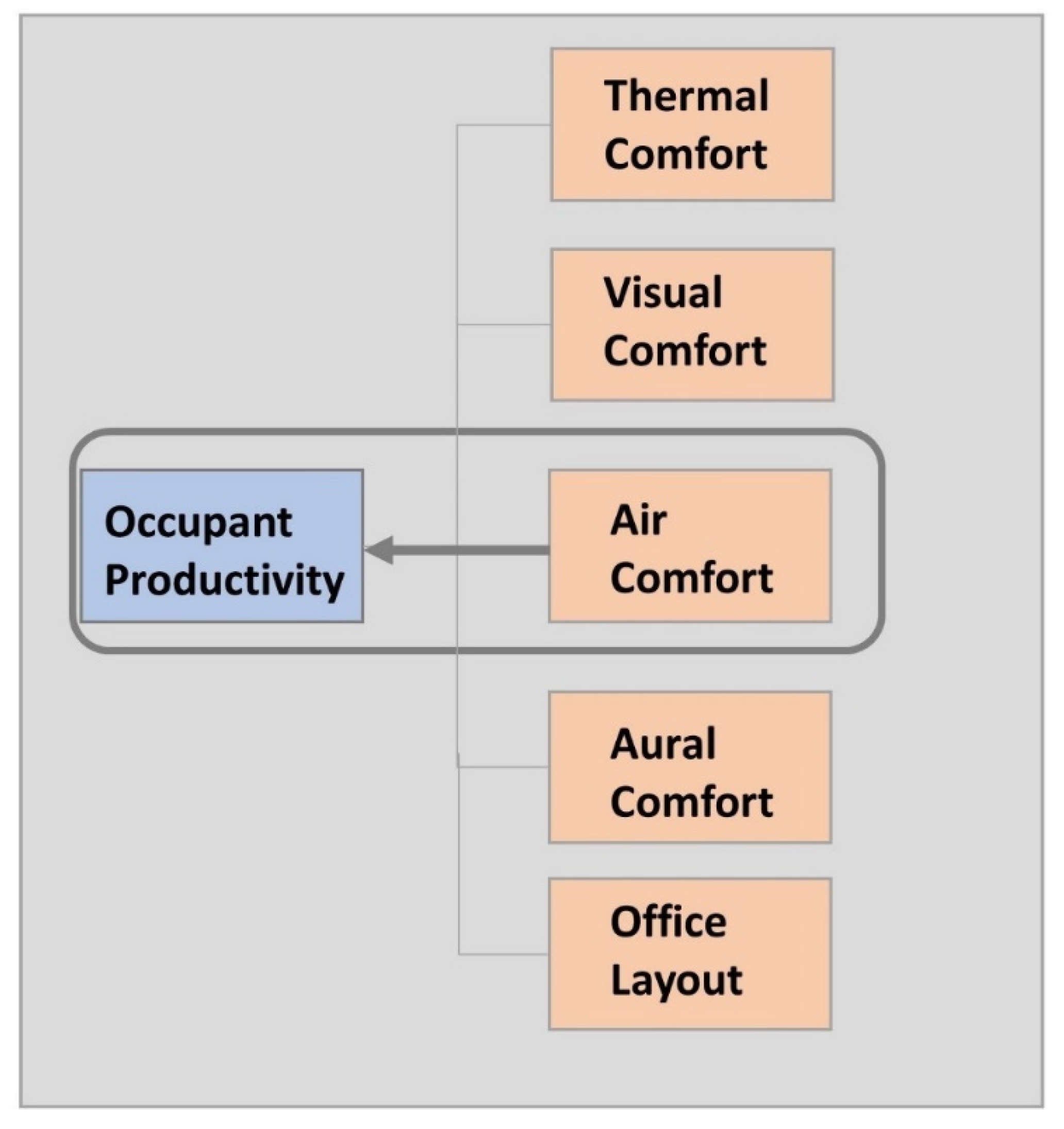
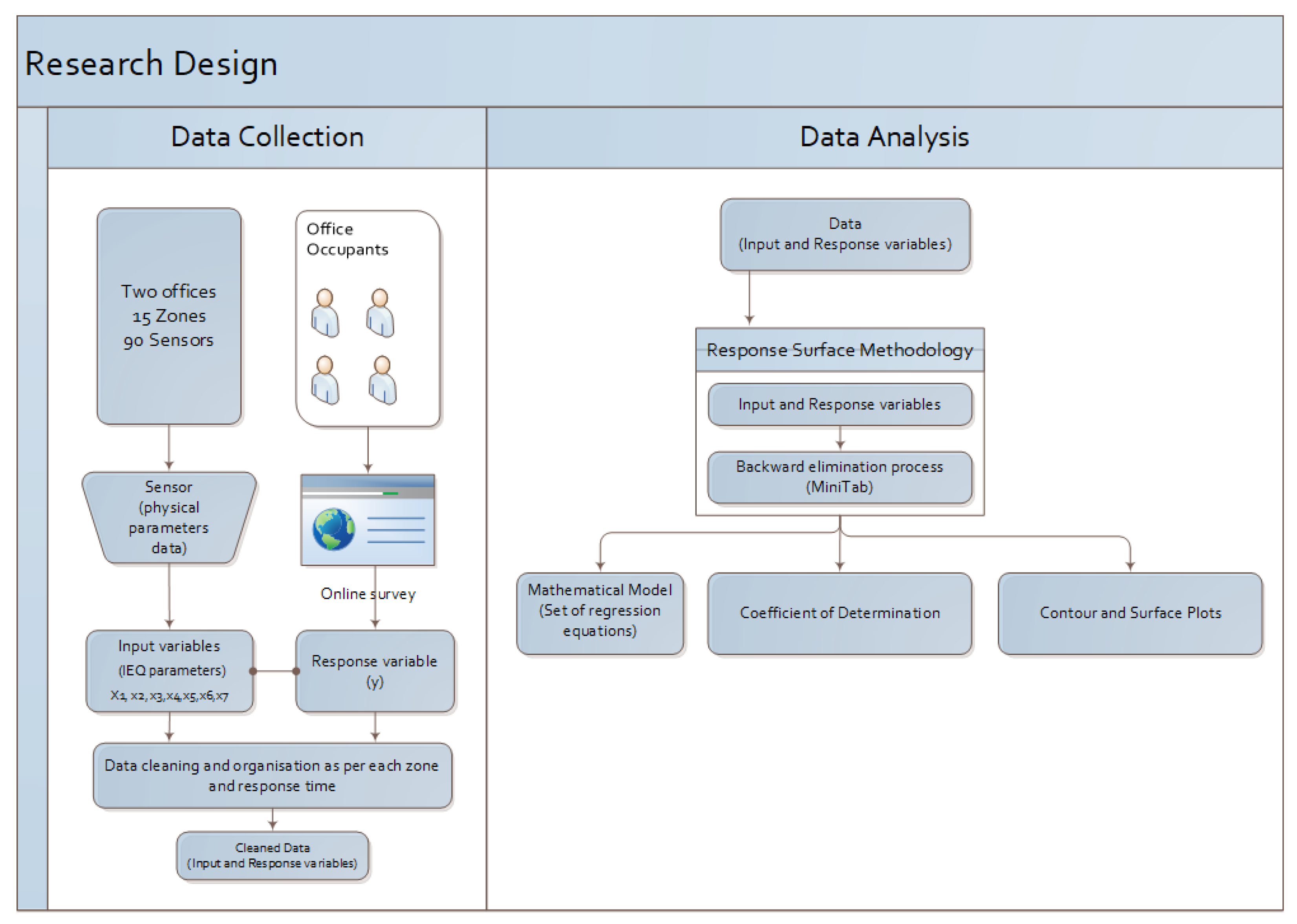
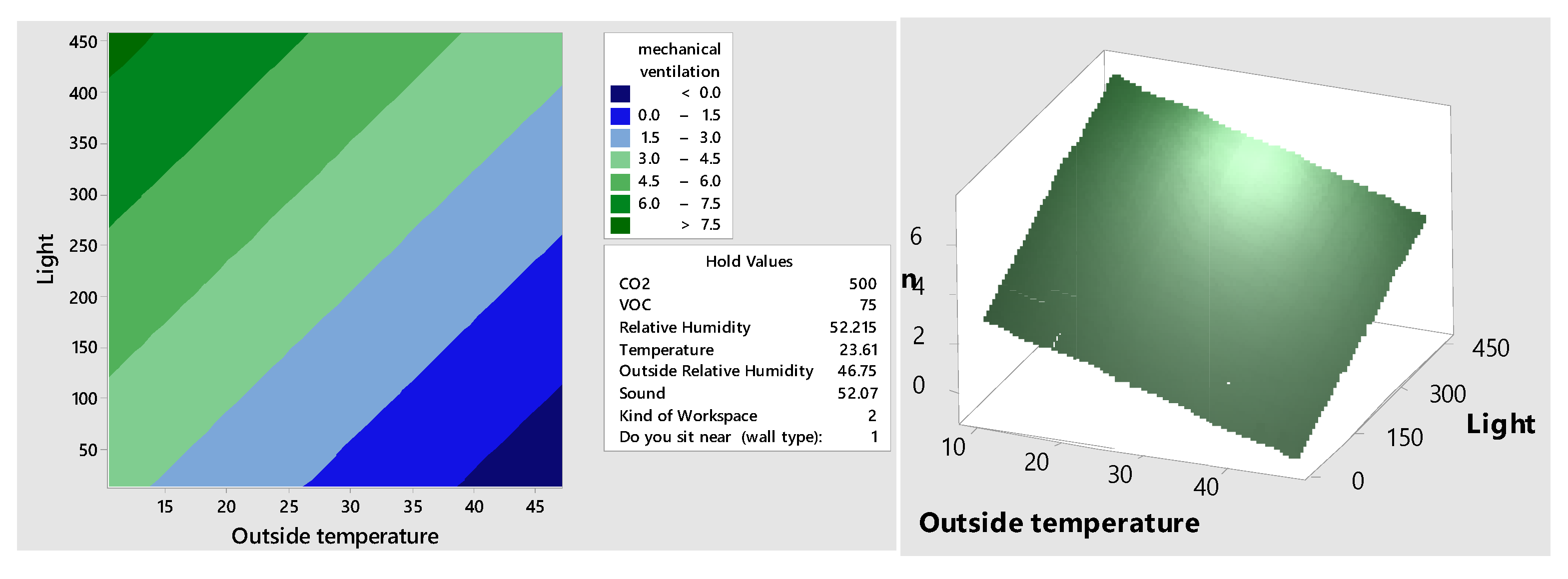


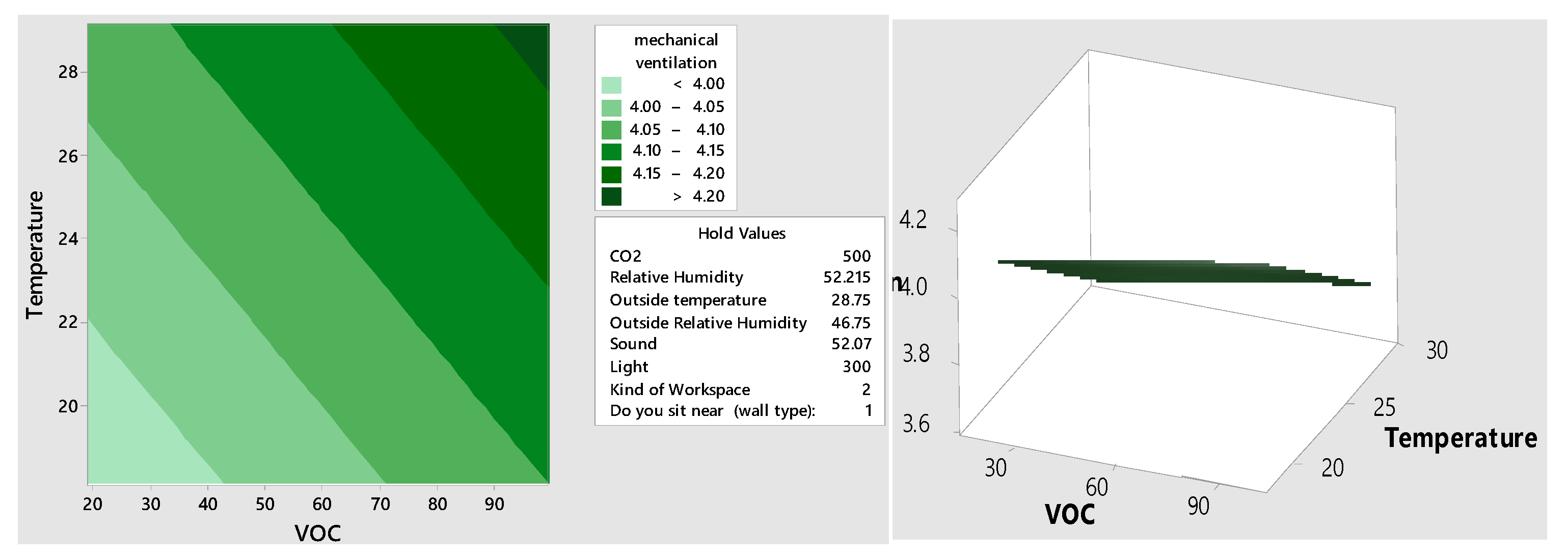
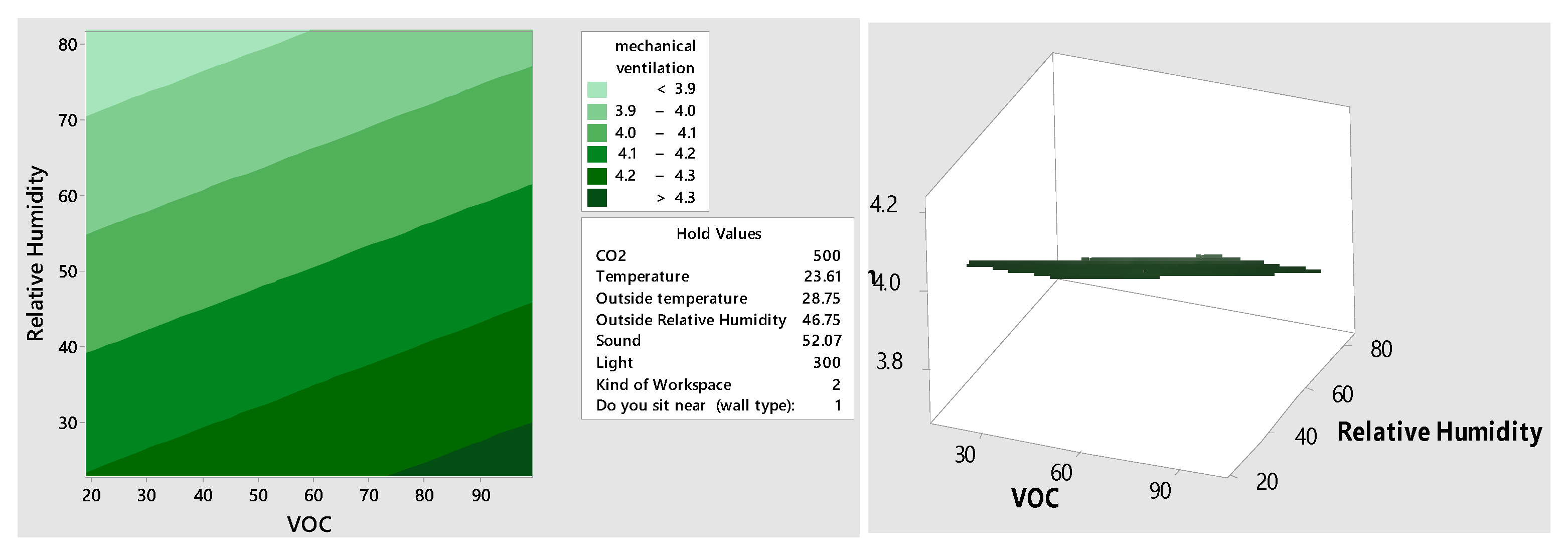
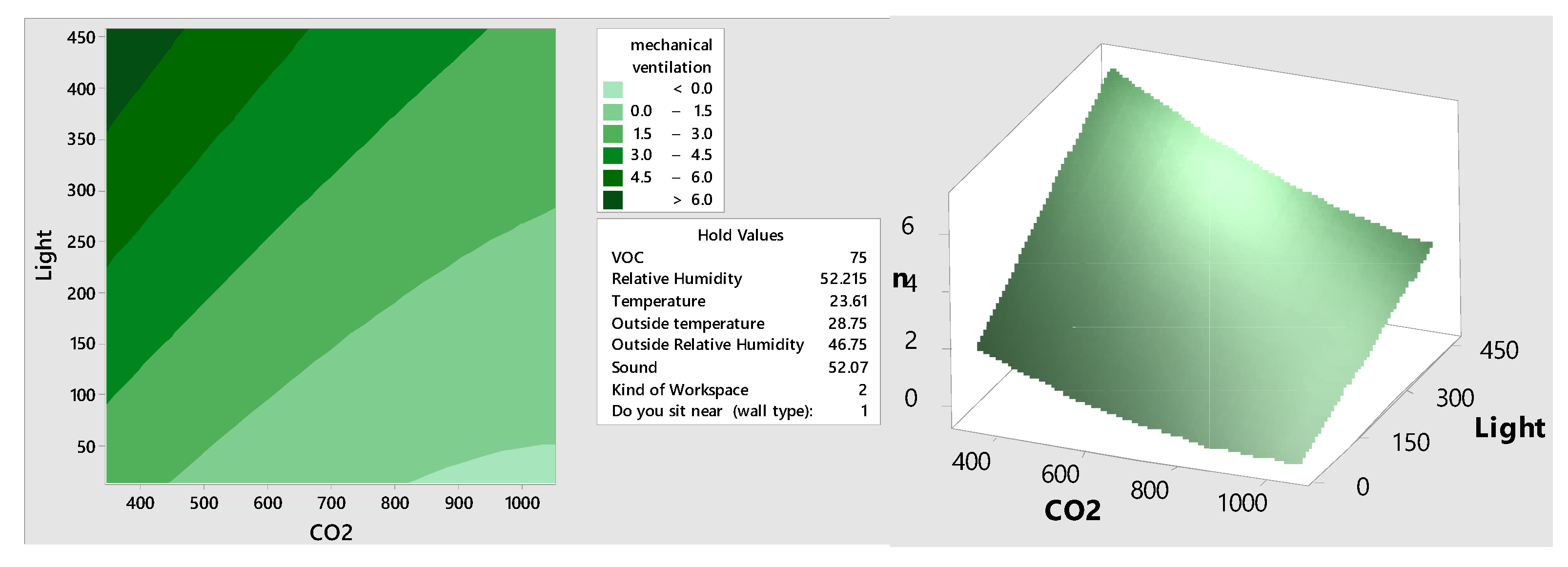
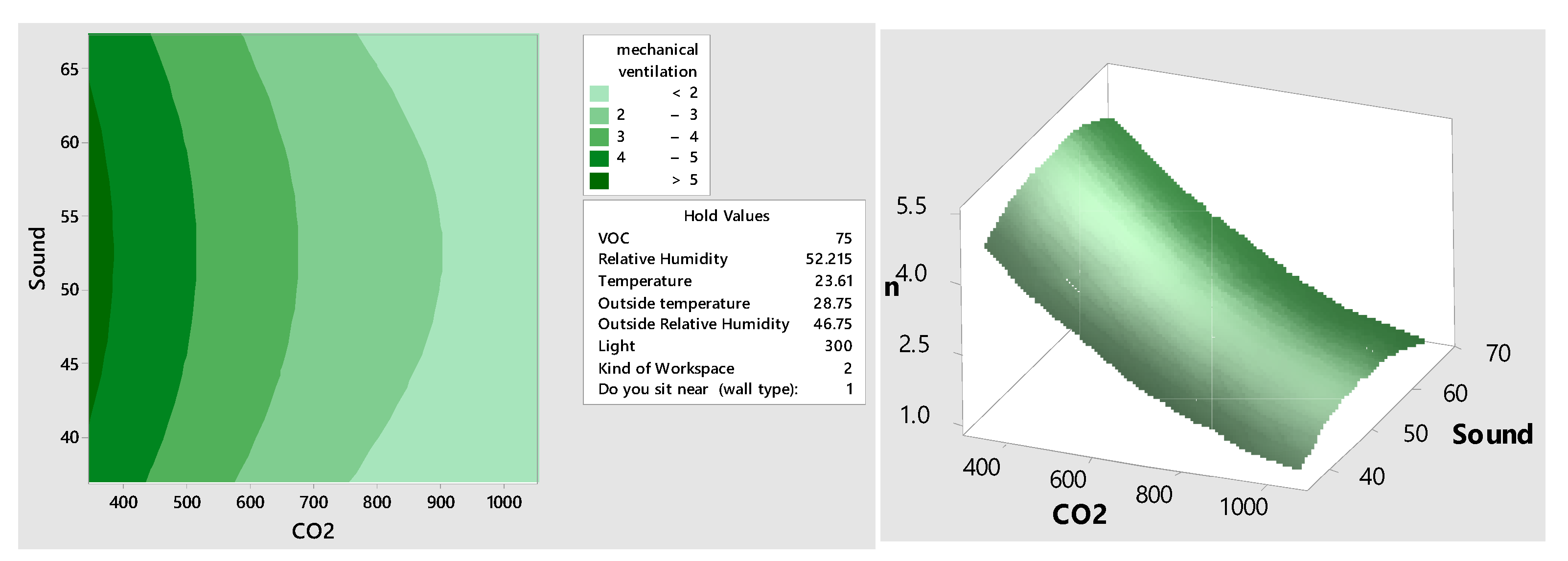
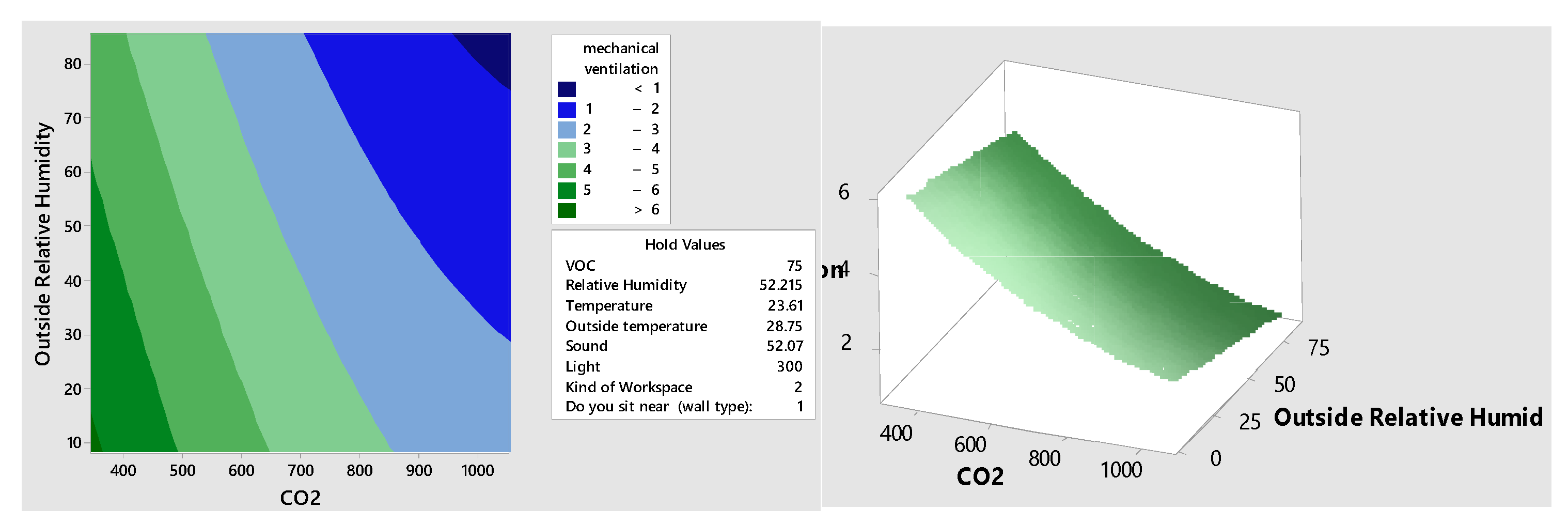

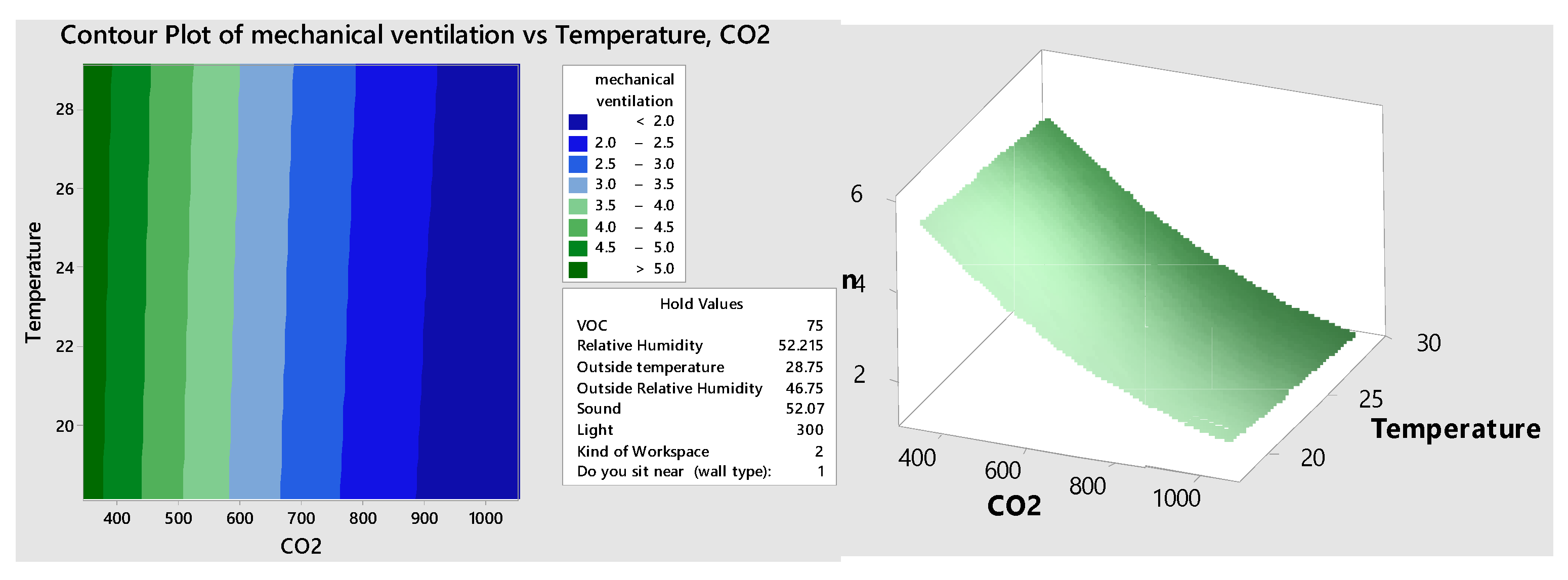
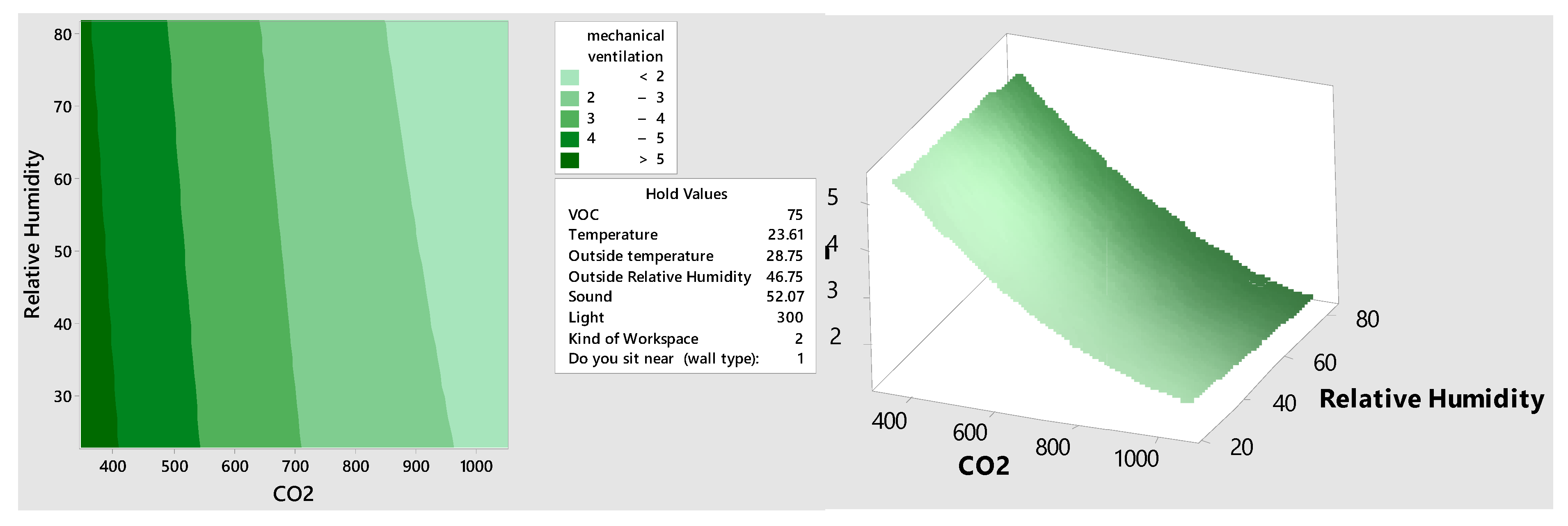
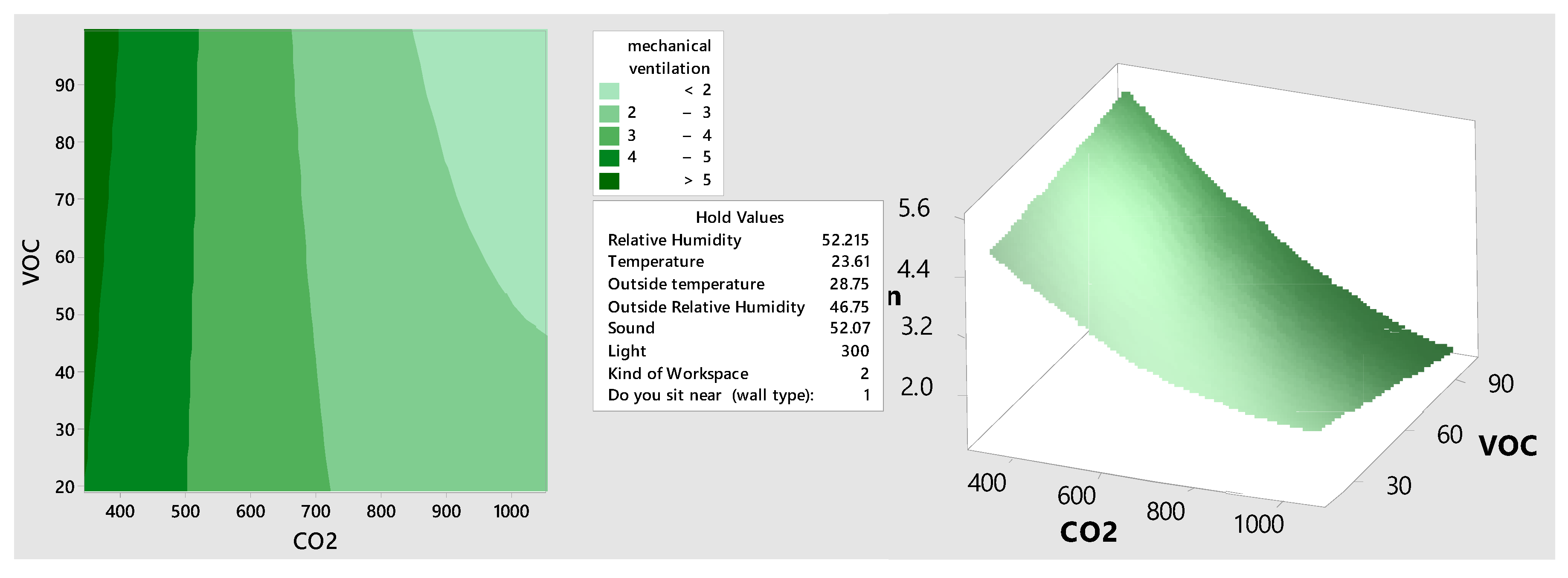
| No | Reference | Focus Area within IAQ | Findings |
|---|---|---|---|
| 1 | [58] | Components of indoor air–VOC | This research provided VOC measurement protocols and data to reduce exposure to pollutant sources. |
| 2 | [22] | Components of indoor air–VOC | Predicting IAQ in office buildings is possible through laboratory emission testing of products. |
| 3 | [61] | Impacts of IAQ on occupants | The research focuses on preventing adverse effects of all IEQ on occupants, including an integrated analysis assessing IAQ. |
| 4 | [21] | Impacts of IAQ on occupants | A study on the comfort of workers in office buildings showed that perceived comfort, including indoor air quality factors, is a phenomenon that deserves more research. |
| 5 | [34] | Components of indoor air | This study emphasizes the importance of designing adaptable spaces as it reveals the association between building characteristics and IEQ, including IAQ. |
| 6 | [32] | Ventilation systems | This paper revealed occupants’ preference for some hybrid ventilation systems over others, specifically those systems that allowed high degrees of direct user control. |
| 7 | [46] | Ventilation systems | This study examines the potential application of ventilation systems with thermal energy storage, revealing how this system saves electrical energy by 16.9–50.8%. |
| 8 | [62] | Impacts of IAQ on occupants | This study reveals the adverse impacts of subdivided housing units on IAQ through increasing levels of CO2 and VOCs, which threatens the health of occupants, especially young children. |
| 9 | [29] | Impacts of IAQ on occupants | The focus of this research was to better understand the impact of several IEQ factors (odours, air movement, available space, etc.) that are not substantial to the overall workspace contentment on their own, but their effects become significant when these factors are merged into broader environmental parameters (i.e., Perceived Air Quality, Acoustics, Layout and Thermal). |
| 10 | [43] | Ventilation systems | This research focuses on the Ventilation rate aspect of the ground source heat pump system from the perspective of energy saving and indoor thermal comfort combined. It constructed different settings that considered various ventilation techniques and different cooling capacities. |
| 11 | [63] | Components of indoor air–CO2 levels | A literature review that summarises results from 37 studies linking high levels of indoor CO2 with impaired cognitive function. |
| 12 | [39] | Ventilation systems | This study uncovers how the application of hybrid or mixed-mode ventilation systems in harsh, dry climates has the potential to provide suitable indoor environments through highly effective office building design. |
| 13 | [56] | Components of indoor air | A critical paper that introduced the Olf and the decipol, the units that provide a rational basis for calculating ventilation requirements and for predicting and measuring air quality indoors and outdoors. |
| 14 | [64] | Impacts of IAQ on occupants | This study examined indoor environmental parameters, including IAQ and building features that primarily affect occupants’ satisfaction in US office buildings. Satisfaction with the amount of space was ranked the most important for workspace satisfaction. |
| 15 | [44] | Ventilation systems | This study focused on the effects of green certifications, ventilation types and office types on occupant satisfaction, revealing that hybrid ventilation systems achieve high environmental satisfaction. |
| 16 | [33] | Impacts of IAQ on occupants | This study presents a post-occupancy evaluation of office spaces over twenty years, revealing that levels of satisfaction were mainly related to spaces of interaction, followed by the amount of light and cleanliness; dissatisfaction was related to sound privacy, followed by temperature and noise level. |
| 17 | [40] | Impacts of IAQ on occupants | This case study compared the effects of naturally ventilated (NV) office environments to mechanically ventilated (MV) offices and revealed that occupants in NV buildings adapted to a vast range of environmental conditions. In contrast, those in MV offices were less tolerant of small changes in their environmental conditions. |
| 18 | [28] | Impacts of IAQ on occupants | A significant study summarises human symptoms and discomfort in the built environment, formulating the Sick Building Syndrome. |
| 19 | [55] | Ventilation systems | This study reveals that although ventilation rates are a significant aspect of controlling airborne concentrations, it does not visibly influence levels of total volatile organic compounds (TVOC). |
| 20 | [25] | Impacts of IAQ on occupants | A significant study that delved into understanding the relationship between indoor air pollution and health in the late 1990s, which also considered the Sick Building Syndrome (SBS). |
| 21 | [45] | Ventilation systems | This study investigated the relationship between different ventilation systems and occupants’ satisfaction in an office environment. It revealed that in Naturally Ventilated (NV) buildings, good thermal conditions were associated with increased overall satisfaction, but there was little noticeable unfavourable impact when thermal performance was poor. In air-conditioned buildings, thermal conditions were linked with negative evaluations of the workspace. Finally, thermal conditions in hybrid ventilated buildings showed positive and negative impacts of similar amounts on overall satisfaction. |
| 22 | [8] | Impacts of IAQ on occupants | This paper’s focus was the impact of indoor air quality on productivity loss in air-conditioned office buildings. |
| 23 | [50] | Components of indoor air—VOC | The focus of this research is to provide a summary of indoor/outdoor air levels of VOCs in buildings. It discusses the methods and techniques that have been applied so far to assess VOCs indoors and outdoors. |
| 24 | [47] | Ventilation systems | This study examined the use of natural and mechanical ventilation in 46 apartments. Occupants prioritised their thermal comfort needs over healthy indoor air quality (IAQ). |
| 25 | [35] | Impacts of IAQ on occupants | This study investigated the effects of thermal discomfort in a workspace on perceived air quality, revealing that when occupants felt warm, they tended to assess the air quality as worse, hence their task performance decreased. |
| 26 | [18] | Components of indoor air–VOC | This study investigated the IAQ in Swedish housing stock, disclosing that even though ventilation appeared to be a source of NO2, increased ventilation rate seemed to reduce the indoor intensities of formaldehyde and total volatile organic compounds. |
| 27 | [37] | Ventilation systems | This study tested the effects of night ventilation on indoor air quality, showing that the night ventilation strategy had insignificant effects on microbial concentrations. At the same time, the VOC levels reached a minimum level after 2 h of ventilation. |
| 28 | [65] | Impacts of IAQ on occupants | This study focused on the impact of air movement on perceived air quality and Sick Building syndrome, demonstrating that the energy-saving strategy of enhancing occupant comfort by moving room air at a high velocity and maintaining a high room temperature at a decreased supply of outdoor air or by a reduction of indoor air enthalpy must be vigilantly employed in buildings as the pollution level can still cause adverse health effects. |
| 29 | [41] | Impacts of IAQ on occupants | The objective of this paper was to identify and critically evaluate research that links indoor environmental quality and individual productivity to develop a theoretical model that links green building features and initiatives in office buildings to individual productivity and organizational performance. |
| 30 | [17] | Impacts of IAQ on occupants | This study suggested five revolutionary principles for a philosophy of excellence for the 21st century: (1) improved indoor air quality enhances productivity and reduces SBS symptoms; (2) redundant indoor pollution causes should be evaded; (3) the air should be cool and dry for occupants; (4) a slight volume of clean air should be served close to the breathing zone of each occupant; (5) occupants should be given control of the indoor thermal environment. |
| 31 | [48] | Components of indoor air–VOC | The focus of this paper was to report on the most common procedures used in determining VOC levels. |
| 32 | [66] | Components of indoor air—CO2 levels | This paper describes the use of Carbon Dioxide in evaluating building IAQ and Ventilation in addition to factors that must be considered, such as ventilation system configuration and occupancy patterns. |
| 33 | [57] | Components of indoor air | This study employed a methodology for evaluating perceived air quality depending on air temperature, air humidity and air pollution caused by humans alongside an added extra parameter: air velocity. |
| 34 | [42] | Components of indoor air—CO2 levels | This research studied the relations of higher indoor carbon dioxide levels with impaired work performance, concluding that there are direct adverse effects of CO2 on human performance that could reduce energy-saving declines in outdoor air ventilation per person in buildings. |
| 35 | [11,15] | Components of indoor air—CO2 levels | These papers reviewed the relationship between ventilation rates and CO2 concentrations in office buildings with occupant health and risk of Sick Building Syndrome. |
| 36 | [26] | Ventilation systems | This study conducted a post-occupancy evaluation of residential buildings with two types of ventilation systems, centralized and decentralized; malfunctions were detected in some of the mechanical ventilation systems in the study. |
| 37 | [31] | Components of indoor air | This paper discusses factors influencing IAQ, retarding, stabilizing and promoting and presents how those factors influence the temperature, relative humidity and CO2 concentration. |
| 38 | [54] | Components of indoor air | This study focuses on what indoor air quality information should be gathered through the early stages of buildings to determine their indoor air quality performance. |
| 39 | [38] | Components of indoor air | This research investigated the perceived air quality, Sick Building Syndrome (SBS) symptoms and productivity in office buildings and demonstrated that ventilation rates should be above the minimum levels prescribed in standards and guidelines in the early 2000s. |
| 40 | [10,49] | Components of indoor air—VOC | Based on an analysis of indoor air pollutants in office environments, it is recommended in this study to measure selected compounds for odour and sensory irritation to assess indoor air quality and minimize irritation symptoms, deteriorated performance and cardiovascular and pulmonary effects. |
| 41 | [37] | Components of indoor air | This study analysed the human response to the indoor climate with two individually controlled convective and radiant cooling systems, emphasizing the need for personalized control to ensure that all occupants are content with indoor conditions. |
| Indoor Air Quality | ||
|---|---|---|
| Measurable Parameters | Instrument | Occupant Survey |
| Indoor pollutant level (Volatile Organic Compound) | Sensor | Occupants’ response to the indoor air quality |
| Carbon Dioxide | Sensor | |
| Indoor Environment Factor | Very Negatively | Negatively | Neutral | Positively | Very Positively | |
|---|---|---|---|---|---|---|
| A | Thermal comfort | |||||
| B | Mechanical ventilation | |||||
| D | Illumination levels | |||||
| E | Daylight | |||||
| F | Glare control | |||||
| G | Views | |||||
| H | Acoustic quality | |||||
| K | Office Layout | |||||
| L | Closeness to nature |
| IEQ Factor | Parameter | Measured by | Input Variable | Response/Performance Variable |
|---|---|---|---|---|
| Thermal Comfort | Temperature (°C) | Zigbee T-3524C | (Calculated from the survey responses) | |
| Relative humidity (%) | ||||
| Outside temperature (°C) | Vantage Pro | |||
| Outside RH (%) | ||||
| Indoor Air Quality | Carbon Dioxide (P.P.M.) | Zigbee T-3571 | ||
| Volatile Organic Compound (V.O.C. free air %) | Zigbee T-3576 | |||
| Illumination | Lux level (lx) | |||
| Noise | Sound level (dB) | Zigbee T-3551 | ||
| Office Layout | Seating arrangement (room layout and access to window) | Researcher (Office plan) |
| S. No. | Independent Variable 1 | Effect & Range | Independent Variable 2 | Effect & Range | Inference |
|---|---|---|---|---|---|
| 1 | Illumination | 250–450 lux | Outside Temperature | Higher temperature leads to a negative impact Range: Below 35 °C | Both illumination and outside temperature influence indoor air comfort |
| 2 | Sound | Minimum or no effect | Outside Temperature | Higher temperature leads to a negative impact Range: Below 35 °C | Outside temperature influences indoor air comfort and productivity |
| 3 | Outside Relative Humidity | Higher outside humidity has a negative impact on indoor air comfort and productivity | Outside Temperature | Higher temperature leads to a negative impact Range: Below 35 °C | Both outside temperature and relative humidity have a negative effect |
| 4 | Temperature | A weak or indirect effect | Volatile Organic Compound | Higher VOC-free air results in better indoor air comfort and productivity Range: 70% & above | VOC presence reduces indoor air quality and productivity |
| 5 | Relative Humidity | Relative humidity has a higher impact than VOC Higher levels of relative humidity contribute to indoor air discomfort and are detrimental to productivity Range: up to 55 dB | Volatile Organic Compound | Weak impact—Lower VOC has a positive effect on indoor air quality. | VOC has less influence compared to relative humidity; however, it affects the impact of relative humidity on indoor air quality |
| 6 | Illumination | 250–450 lux | Carbon Dioxide | 600 ppm or below | Both illumination and carbon dioxide affect indoor air quality |
| 7 | Sound | No significant impact | Carbon Dioxide | 600 ppm | Carbon Dioxide has a strong impact |
| 8 | Outside Relative Humidity | No significant impact | Carbon Dioxide | 650 ppm or below | Carbon Dioxide has a strong impact |
| 9 | Outside Temperature | Positive impact up to 35°c | Carbon Dioxide | 800 ppm or below | Both outside temperature and carbon dioxide affect indoor air quality |
| 10 | Temperature | No significant impact | Carbon Dioxide | 500 ppm or below | Carbon Dioxide has a strong impact |
| 11 | Relative Humidity | No significant impact | Carbon Dioxide | 700 ppm or below | Carbon Dioxide has a strong impact |
| 12 | Volatile Organic Compound | No significant impact | Carbon Dioxide | 500 ppm or below | Carbon Dioxide has a strong impact |
Publisher’s Note: MDPI stays neutral with regard to jurisdictional claims in published maps and institutional affiliations. |
© 2022 by the authors. Licensee MDPI, Basel, Switzerland. This article is an open access article distributed under the terms and conditions of the Creative Commons Attribution (CC BY) license (https://creativecommons.org/licenses/by/4.0/).
Share and Cite
Kaushik, A.K.; Arif, M.; Syal, M.M.G.; Rana, M.Q.; Oladinrin, O.T.; Sharif, A.A.; Alshdiefat, A.S. Effect of Indoor Environment on Occupant Air Comfort and Productivity in Office Buildings: A Response Surface Analysis Approach. Sustainability 2022, 14, 15719. https://doi.org/10.3390/su142315719
Kaushik AK, Arif M, Syal MMG, Rana MQ, Oladinrin OT, Sharif AA, Alshdiefat AS. Effect of Indoor Environment on Occupant Air Comfort and Productivity in Office Buildings: A Response Surface Analysis Approach. Sustainability. 2022; 14(23):15719. https://doi.org/10.3390/su142315719
Chicago/Turabian StyleKaushik, Amit Kant, Mohammed Arif, Matt M. G. Syal, Muhammad Qasim Rana, Olugbenga Timo Oladinrin, Ahlam Ammar Sharif, and Ala’a Saleh Alshdiefat. 2022. "Effect of Indoor Environment on Occupant Air Comfort and Productivity in Office Buildings: A Response Surface Analysis Approach" Sustainability 14, no. 23: 15719. https://doi.org/10.3390/su142315719
APA StyleKaushik, A. K., Arif, M., Syal, M. M. G., Rana, M. Q., Oladinrin, O. T., Sharif, A. A., & Alshdiefat, A. S. (2022). Effect of Indoor Environment on Occupant Air Comfort and Productivity in Office Buildings: A Response Surface Analysis Approach. Sustainability, 14(23), 15719. https://doi.org/10.3390/su142315719











